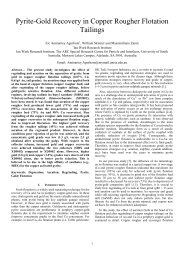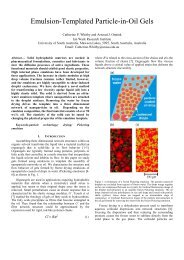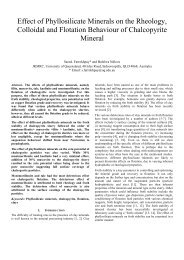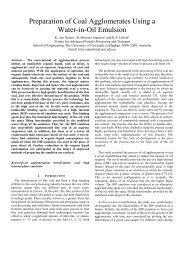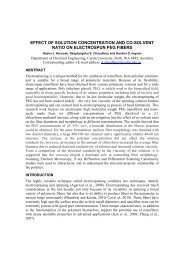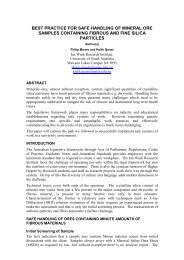One-pot Synthesis of Mesoporous La(OH)3 Adsorbent and its ...
One-pot Synthesis of Mesoporous La(OH)3 Adsorbent and its ...
One-pot Synthesis of Mesoporous La(OH)3 Adsorbent and its ...
- No tags were found...
Create successful ePaper yourself
Turn your PDF publications into a flip-book with our unique Google optimized e-Paper software.
<strong>One</strong>-<strong>pot</strong> <strong>Synthesis</strong> <strong>of</strong> <strong>Mesoporous</strong> <strong>La</strong>(<strong>OH</strong>) 3<br />
<strong>Adsorbent</strong> <strong>and</strong> <strong>its</strong> Application for Phosphate Removal<br />
Wei-Ya Huang 1,2,3 , Xuelei Wang 2 , Dan Li 1* , Goen Ho 1 , Yuan-Ming Zhang 2*<br />
1 Environmental Engineering, School <strong>of</strong> Engineering <strong>and</strong> Information Technology, Murdoch University,<br />
Murdoch, Western Australia, 6150, Australia;<br />
2 Department <strong>of</strong> Chemistry, Jinan University, Guangzhou, 510632, China;<br />
3 Department <strong>of</strong> Materials Science <strong>and</strong> Engineering, Taizhou University, Linhai, 317000, China;<br />
* Corresponding authors, D. Li: Tel.: +61 08 9360 2569, Email: L.Li@murdoch.edu.au; Y-M Zhang: Tel.:<br />
+86 20 8522 1264, Email: Tzhangym@gmail.com<br />
Abstract— In this study, we reported the one-<strong>pot</strong> synthesis <strong>of</strong><br />
mesoporous <strong>La</strong>(<strong>OH</strong>) 3 adsorbent (Meso-<strong>La</strong>(<strong>OH</strong>) 3 ) <strong>and</strong> <strong>its</strong><br />
application in phosphate removal for the first time. The<br />
synthesized <strong>La</strong>(<strong>OH</strong>) 3 sample exhibited an irregular particle<br />
shape <strong>and</strong> possessed mesopores. In the phosphate adsorption<br />
test, the experiment equilibrium data were fitted better by<br />
using the <strong>La</strong>ngmuir model than the Freundlich model,<br />
suggesting that the adsorption feature be monolayer. Our<br />
results showed that Meso-<strong>La</strong>(<strong>OH</strong>) 3 had a maximum phosphate<br />
adsorption capacity <strong>of</strong> 57.65 mg P/g.<br />
Keyword-<strong>La</strong>(<strong>OH</strong>) 3 ; mesoporous; phosphate; adsorption<br />
I. INTRODUCTION<br />
To date, water eutrophication has become a severe global<br />
environmental problem, which leads to overgrowth <strong>of</strong> algae,<br />
depletion <strong>of</strong> dissolved oxygen, <strong>and</strong> in turn deterioration <strong>of</strong><br />
water quality [1]. <strong>One</strong> <strong>of</strong> the major factors causing water<br />
eutrophication is the discharge <strong>of</strong> excessive nutrients,<br />
especially phosphate, into water systems. Until now, intensive<br />
effort has been devoted toward various strategies to remove<br />
phosphate from water, including biological activated sludge<br />
process, physical adsorption, <strong>and</strong> chemical precipitation [2].<br />
Among those methods, physical adsorption has been<br />
commonly studied in the removal <strong>of</strong> phosphate due to the good<br />
removal efficiency <strong>and</strong> removal rate [2-4]. In the adsorption<br />
method, it is necessary to develop highly efficient, low-cost<br />
<strong>and</strong> easily available adsorbents. So far, a large number <strong>of</strong><br />
adsorbents have been studied to remove phosphate anions from<br />
aqueous solution [5-9], such as goethite, vesuvianite, layered<br />
double hydroxides, etc.<br />
In recent years, the utilization <strong>of</strong> materials with<br />
mesoporosity as adsorbents has become an increasing area <strong>of</strong><br />
research. In particular, after introducing the M41S family <strong>of</strong><br />
ordered mesoporous silica [10], their unique structural<br />
properties, such as high surface area <strong>and</strong> uniform pore size,<br />
have attracted great interest. However, despite the mesoporous<br />
silicas, e.g. MCM-41, MCM-48 <strong>and</strong> SBA-15, possess many<br />
attractive features as adsorbents, their adsorption capacities for<br />
phosphate are reported to be extremely low [11, 12], since their<br />
surface Si-<strong>OH</strong> can hardly capture phosphate anions from<br />
aqueous solution. Metal doping method is suggested as an<br />
effective way to improve the adsorption capacities <strong>of</strong><br />
mesoporous silicas working as phosphate adsorbents. For<br />
instance, Zhang et al. fabricated a series <strong>of</strong> lanthanum-doped<br />
mesoporous MCM-41 as adsorbents to remove phosphate [13].<br />
It was found that the phosphate adsorption capacities increased<br />
when greater amount <strong>of</strong> <strong>La</strong> was incorporated. The sample<br />
<strong>La</strong> 25 M41 prepared with the Si/<strong>La</strong> molar ratio <strong>of</strong> 25 possessed a<br />
high <strong>La</strong>ngmuir adsorption capacity, which was 22.0 mg P/g<br />
[13]. Yang et al. reported that the <strong>La</strong>-doped SBA-15 adsorbent,<br />
<strong>La</strong> 100 SBA-15, which was synthesized with the<br />
<strong>La</strong>(NO 3 ) 3·6H 2 O/SBA-15 mass ratio <strong>of</strong> 1, had a maximum<br />
adsorption capacity <strong>of</strong> 45.63 mg P/g [14]. As compared to<br />
calcium, aluminum or iron, lanthanum-modified adsorbents<br />
show several promising advantages in phosphate removal, such<br />
as superior adsorption capacity, wide operating pH range, <strong>and</strong><br />
high removal rate in low phosphate concentration [15, 16].<br />
Although the metal doping <strong>of</strong> silica-based materials has been<br />
studied in phosphate removal; some demer<strong>its</strong> are recognized,<br />
such as possibly reduced pore sizes <strong>of</strong> mesoporous materials,<br />
time-consuming <strong>and</strong> costly fabrication.<br />
In this paper, the objective is to prepare mesoporous<br />
<strong>La</strong>(<strong>OH</strong>) 3 via a one-<strong>pot</strong> synthetic method <strong>and</strong> investigate <strong>its</strong> use<br />
for phosphate removal, which to the best <strong>of</strong> our knowledge is<br />
reported for the first time. Herein, it is expected that our<br />
adsorbent will possess a superior adsorption capacity, which<br />
will be a highly efficient adsorbent for removing phosphate. In<br />
this paper, the fabrication, characterization <strong>and</strong> phosphate<br />
adsorption performances <strong>of</strong> mesoporous <strong>La</strong>(<strong>OH</strong>) 3 are detailed.<br />
II.<br />
EXPERIMENTALS<br />
A. <strong>Synthesis</strong> <strong>of</strong> <strong>La</strong>(<strong>OH</strong>) 3<br />
In a typical synthesis, 1.0 g <strong>La</strong>(NO 3 ) 3·6H 2 O was dissolved<br />
in 1 mL deionized water; after which, 1 mL propionic acid <strong>and</strong><br />
30 mL glycol were added with stirring to form a uniform
solution. The resulting mixture was sealed in an autoclave <strong>and</strong><br />
heated at 180 °C for 200 min. The product was then<br />
centrifuged, washed with water <strong>and</strong> ethanol, <strong>and</strong> dried at 80 °C<br />
in air. The as-synthesized sample is denoted as Meso-<strong>La</strong>(<strong>OH</strong>) 3.<br />
B. Characterization <strong>of</strong> materials<br />
X-ray powder diffraction (XRD) patter was recorded in the<br />
2θ range <strong>of</strong> 10–70 ° with a scan speed <strong>of</strong> 2 °/min by using a<br />
diffractometer (Siemens D500 series) with Cu Kα radiation (30<br />
mA, 40 kV). Surface morphology <strong>of</strong> the sample was examined<br />
by scanning electron microscopy (SEM, Zeiss Neon 40EsB<br />
FIBSEM). Transmission electron microscopy (TEM,<br />
JEM2010) was used to characterize the sample at an<br />
accelerating voltage <strong>of</strong> 200 kV. The sample was firstly<br />
dispersed in ethanol via sonication <strong>and</strong> then was collected with<br />
a carbon copper grid for TEM characterization. Nitrogen<br />
adsorption-desorption isotherm was measured at 77 K using<br />
ASAP 2010 (Micromeritics Inc., USA). Prior to analysis, the<br />
sample was degassed at 120 °C for 12 h under vacuum. The<br />
specific surface area, S BET , was determined from the linear part<br />
<strong>of</strong> the BET plot (P/P 0 = 0.05-0.20). The pore size, d, was<br />
calculated from the desorption branch <strong>of</strong> isotherm by using<br />
Barrett-Joyner-Hallenda (BJH). The total pore volume, V total ,<br />
was evaluated from the adsorbed nitrogen amount at a relative<br />
pressure <strong>of</strong> 0.98.<br />
C. Phosphate adsorption experiments<br />
A series <strong>of</strong> batch tests were conducted to investigate the<br />
phosphate adsorption performance <strong>of</strong> the Meso-<strong>La</strong>(<strong>OH</strong>) 3<br />
adsorbent. In the equilibrium experiment, 0.025 g <strong>of</strong> the<br />
adsorbent was added into 50 mL <strong>of</strong> phosphate solution with<br />
various initial concentrations in a polypropylene bottle, which<br />
was prepared by dissolving anhydrous K 2 HPO 4 (analytical<br />
grade, Sinopharm Chemical Reagent Co., Ltd) in deionized<br />
water. After shaken for 24 h at 25 °C, the solution was<br />
removed by filtering through a syringe nylon-membrane filter<br />
(pore size 0.45 μm; Shanghai Xinya Purification Devices<br />
Factory). The concentraiton <strong>of</strong> phosphate in filtrate was<br />
analyzed by Autoanalyzer 3 (Bran <strong>and</strong> Luebbe Inc., Germany).<br />
The amount <strong>of</strong> phosphate adsorbed on the sample at the<br />
equilibrium (q e ) was calculated by,<br />
q =<br />
e<br />
( 0<br />
(1)<br />
C − Ce)<br />
× V<br />
m<br />
where C 0 <strong>and</strong> C e are the initial <strong>and</strong> equilibrium phosphate<br />
concentrations in solution (mg/L), respectively; V is the<br />
volume <strong>of</strong> solution (L) <strong>and</strong> m is the mass <strong>of</strong> adsorbent (g).<br />
The equilibrium data were fitted to the well-known<br />
<strong>La</strong>ngmuir <strong>and</strong> Freundlich isotherm models [17, 18], as shown<br />
in (2) <strong>and</strong> (3), respectively:<br />
<strong>La</strong>ngmuir model: C<br />
q<br />
e<br />
1<br />
=<br />
q K<br />
e<br />
+<br />
0<br />
L<br />
C<br />
q<br />
e<br />
0<br />
(2)<br />
Freundlich model:<br />
1<br />
log qe<br />
= log KF<br />
+ logC<br />
(3)<br />
e<br />
n<br />
where C e is the concentration <strong>of</strong> phosphate solution at<br />
equilibrium (mg/L); q e is the corresponding adsorption capacity<br />
(mg/g); q 0 (mg/g) <strong>and</strong> K L (L/mg) are the constants in <strong>La</strong>ngmuir<br />
isotherm model which are related to adsorption capacity <strong>and</strong><br />
energy or net enthalpy <strong>of</strong> adsorption, respectively; K F (mg/g)<br />
<strong>and</strong> n are the constants in Freundlich isotherm model, which<br />
measure the adsorption capacity <strong>and</strong> intensity, respectively.<br />
III.<br />
RESULTS AND DISCUSSIONS<br />
The formation process <strong>of</strong> Meso-<strong>La</strong>(<strong>OH</strong>) 3 is speculated to be<br />
a two-stage growth model based on the literature [19]. Ethylene<br />
glycol <strong>and</strong> ester are suggested to work as structure-directing<br />
agents to modify particle surface; thus affecting the nucleation,<br />
aggregation <strong>and</strong> growth <strong>of</strong> particles, <strong>and</strong> subsequently forming<br />
mesoporous structures. As shown in Scheme 1, firstly, the<br />
<strong>La</strong> 3+ ions hydrolyze to form nano-sized <strong>La</strong>(<strong>OH</strong>) 3 crystalline<br />
precursors in the solvothermal synthesis. Ethylene glycol is<br />
absorbed on the nano-sized <strong>La</strong>(<strong>OH</strong>) 3 surface. Meanwhile,<br />
propanoic acid reacts with ethylene glycol via an esterification<br />
process, thus enhancing the particle surface modification.<br />
Finally, the pre-formed small particles assemble <strong>and</strong> grow into<br />
larger secondary particles. After removing the structuredirecting<br />
agents, the mesoporous <strong>La</strong>(<strong>OH</strong>) 3 is obtained.<br />
Scheme 1. The formation <strong>of</strong> Meso-<strong>La</strong>(<strong>OH</strong>) 3 [19].<br />
Figure 1. XRD pattern <strong>of</strong> Meso-<strong>La</strong>(<strong>OH</strong>) 3.<br />
Fig.1 shows X-ray diffraction pattern <strong>of</strong> Meso-<strong>La</strong>(<strong>OH</strong>) 3 .<br />
The low intensity <strong>of</strong> peaks is probably due to the low degree <strong>of</strong><br />
powder crystallization. As seen, several peaks are observed in<br />
the XRD pattern, corresponding to the reflections <strong>of</strong> <strong>La</strong>(<strong>OH</strong>) 3<br />
(JCPDS card 36-1481), which indicate that the as-synthesized<br />
sample is <strong>La</strong>(<strong>OH</strong>) 3 .
Figure 2. SEM (a) <strong>and</strong> TEM images (b <strong>and</strong> c) <strong>of</strong> Meso-<strong>La</strong>(<strong>OH</strong>) 3.<br />
Fig. 2 shows SEM <strong>and</strong> TEM images <strong>of</strong> Meso-<strong>La</strong>(<strong>OH</strong>) 3 . In<br />
Fig. 2a <strong>and</strong> b, the sample exhib<strong>its</strong> an irregular shape with a<br />
wide range <strong>of</strong> particle size distribution. From the TEM image<br />
(Fig. 2c), there are clear voids with a diameter <strong>of</strong> 5-10 nm<br />
inside the particle, revealing the mesostructure <strong>of</strong> Meso-<br />
<strong>La</strong>(<strong>OH</strong>) 3 .<br />
Figure 4. <strong>La</strong>ngmuir <strong>and</strong> Freundlich adsorption isotherms <strong>of</strong> Meso-<br />
<strong>La</strong>(<strong>OH</strong>) 3.<br />
TABLE II. LANGMUIR AND FREUNDLICH ISOTHERMS PARAMETERS IN<br />
THE PHOSPHATE ADSORPTION BY USING MESO-LA(<strong>OH</strong>) 3.<br />
Sample<br />
Meso-<br />
<strong>La</strong>ngmuir<br />
Freundlich<br />
q 0 (mg/g) K L (L/mg) R 2 n K F(mg/g) R 2<br />
57.65 2.41 0.964 4.98 27.98 0.802<br />
<strong>La</strong>(<strong>OH</strong>) 3<br />
TABLE III. COMPARISON OF PHOSPHATE ADSORPTION CAPACITIES<br />
BETWEEN MESO-LA(<strong>OH</strong>) 3 AND OTHER LANTHANUM-MODIFIED ADSORBENTS<br />
SELECTED FROM LITERATURE.<br />
<strong>Adsorbent</strong>s<br />
Temperature<br />
(°C)<br />
Adsorption capacity<br />
(mg P/g)<br />
Ref.<br />
Figure 3. N 2 adsorption-desorption isotherm <strong>and</strong> the corresponding BJH<br />
pore size distribution plot (the inset) <strong>of</strong> Meso-<strong>La</strong>(<strong>OH</strong>) 3.<br />
TABLE I. TEXTUAL STRUCTURE CHARACTERISTICS OF MESO-LA(<strong>OH</strong>) 3.<br />
Sample S BET (m 2 /g) d (nm) V total (cm 3 /g)<br />
Meso-<strong>La</strong>(<strong>OH</strong>) 3 65.6 8.74 0.153<br />
Fig. 3 shows N 2 adsorption–desorption isotherm <strong>of</strong> Meso-<br />
<strong>La</strong>(<strong>OH</strong>) 3 <strong>and</strong> <strong>its</strong> corresponding BJH pore size distribution plot<br />
(the inset in Fig. 3). Table I summarizes the textual structure<br />
characteristics, including BET surface area (S BET ), pore<br />
diameter (d), <strong>and</strong> total pore volume (V total ). The N 2 adsorption–<br />
desorption isotherm exhib<strong>its</strong> type IV isotherm model according<br />
to the IUPAC classification st<strong>and</strong>ard, implying the<br />
mesostructure in the sample [20]. The inset in Fig. 3 shows a<br />
wide pore size distribution in Meso-<strong>La</strong>(<strong>OH</strong>) 3 , proving the<br />
presence <strong>of</strong> mesopores in the particles.<br />
PhoslockTM 23 10.2 [21]<br />
<strong>La</strong>-treated bark fiber 25 10.9 [16]<br />
<strong>La</strong>-loaded orange<br />
waste<br />
30 13.9 [22]<br />
<strong>La</strong>-modified MCM-41 25 17.7 [23]<br />
<strong>La</strong>-doped SBA-15 25 45.6 [14]<br />
Meso-<strong>La</strong>(<strong>OH</strong>) 3 25 57.7 Our work<br />
Fig. 4 shows the <strong>La</strong>ngmuir <strong>and</strong> Freundlich adsorption<br />
isotherms <strong>of</strong> Meso-<strong>La</strong>(<strong>OH</strong>) 3 . In Fig. 4 <strong>and</strong> Table II, the<br />
experimental equilibrium data are fitted better by using the<br />
<strong>La</strong>ngmuir model (R 2 = 0.964) than the Freundlich model (R 2 =<br />
0.802), suggesting the adsorption feature onto Meso-<strong>La</strong>(<strong>OH</strong>) 3<br />
be monolayer. To further evaluate the applicability <strong>of</strong> our<br />
fabricated adsorbent, Table III presents the comparison <strong>of</strong><br />
adsorption capacity <strong>of</strong> Meso-<strong>La</strong>(<strong>OH</strong>) 3 , which was calculated by<br />
the <strong>La</strong>ngmuir model, with other lanthanum-modified<br />
adsorbents used for phosphate removal in literature. The<br />
maximum adsorption capacity <strong>of</strong> Meso-<strong>La</strong>(<strong>OH</strong>) 3 estimated by<br />
the <strong>La</strong>ngmuir model is 57.7 mg P/g. It clearly shows that,<br />
despite there is a slight difference in test temperatures, our<br />
prepared Meso-<strong>La</strong>(<strong>OH</strong>) 3 exhib<strong>its</strong> a superior phosphate<br />
adsorption capacity, when compared to those reported<br />
adsorbents. Especially, <strong>its</strong> phosphate adsorption capacity is<br />
significantly greater than those <strong>of</strong> lanthanum-modified<br />
mesoporous silicas, e.g. MCM-41 <strong>and</strong> SBA-15, respectively.
CONCLUSION<br />
We have successfully prepared the mesoporous <strong>La</strong>(<strong>OH</strong>) 3<br />
(Meso-<strong>La</strong>(<strong>OH</strong>) 3 ) via a simple one-<strong>pot</strong> synthetic method <strong>and</strong><br />
utilized it to remove phosphate for the first time. The assynthesized<br />
Meso-<strong>La</strong>(<strong>OH</strong>) 3 exhibited an irregular shape <strong>and</strong><br />
possessed mesopores, which were confirmed by using TEM,<br />
SEM <strong>and</strong> nitrogen adsorption-desorption isotherm. Moreover,<br />
our adsorbent had a better phosphate adsorption capacity, as<br />
compared with those reported in literature. Therefore, our study<br />
<strong>of</strong>fers a simple <strong>and</strong> scalable approach to fabricate an adsorbent<br />
with a superior phosphate adsorption performance. Future work<br />
will study <strong>its</strong> performance <strong>and</strong> feasibility for practical<br />
phosphate removal in wastewater, which especially contains a<br />
wide range <strong>of</strong> contaminants, such as organic substances <strong>and</strong><br />
competitive ions, in detail. On the other h<strong>and</strong>, the optimization<br />
<strong>and</strong> adjustment on the porous structure <strong>of</strong> our adsorbent is<br />
expected to further enhance <strong>its</strong> phosphate adsorption capacity.<br />
ACKNOWLEDGEMENTS<br />
This work was supported by Natural Science Foundation <strong>of</strong><br />
Guangdong (No. S2011040001667), the Fundamental Research<br />
Funds for the Central Universities (No. 21611310), the<br />
National High Technology Research <strong>and</strong> Development<br />
Program <strong>of</strong> China (863 Program) (No. 2009AA064401), <strong>and</strong><br />
the Key <strong>La</strong>boratory <strong>of</strong> Mineralogy <strong>and</strong> Metallogeny<br />
Cooperation Foundation (No. KLMM20110204). Ms Wei-Ya<br />
Huang’ study was supported by the program <strong>of</strong> China<br />
Scholarships Council (No.201206780010).<br />
References<br />
[1] K.G. Sellner, G.J. Doucette, G.J. Kirkpatrick, “Harmful algal blooms:<br />
causes, impacts <strong>and</strong> detection,” J. Ind. Microbiol. Biotechnol., vol. 30,<br />
pp. 383–406, 2003.<br />
[2] G.K. Morse, S.W. Brett, J.A. Guy, J.N. Lester, “Review: Phosphorus<br />
removal <strong>and</strong> recovery technologies,” Sci. Total Environ., vol. 212, pp.<br />
69–81, 1998.<br />
[3] G. Zhang, H. Liu, R. Liu, J. Qu, “Removal <strong>of</strong> phosphate from water by a<br />
Fe-Mn binary oxide adsorbent,” J. Colloid Interface Sci., vol. 335, pp.<br />
168-174, 2009.<br />
[4] P. Ning, H.J. Bart, B. Li, X. Lu, Y. Zhang, “Phosphate removal from<br />
wastewater by model-<strong>La</strong>(III) zeolite adsorbents,” J. Environ. Sci., vol.<br />
20, pp. 670-674, 2008.<br />
[5] Z. Hongshao, R. Stanforth, “Competitive adsorption <strong>of</strong> phosphate <strong>and</strong><br />
arsenate on goethite, ” Environ. Sci. Technol., vol. 35, pp. 4753-4757,<br />
2001.<br />
[6] F. Gan, J. Zhou, H. Wang, C. Du, X. Chen, “Removal <strong>of</strong> phosphate from<br />
aqueous solution by thermally treated natural palygorskite,” Water Res.,<br />
vol. 43 (11), pp. 2907–2915, 2009.<br />
[7] H. Li, J. Ru, W Yin, X. Liu, J. Wang, W. Zhang, “Removal <strong>of</strong> phosphate<br />
from polluted water by lanthanum doped vesuvianite,” J. Hazard.<br />
Mater., vol. 168, pp. 326-330, 2009.<br />
[8] P. Papadopoulos, A. Dimirkou, A. Ioannou, “Kinetics <strong>of</strong> phosphorus<br />
sorption by goethite <strong>and</strong> kaolinite–goethite (k–g) system,” Commun,<br />
Soil Sci. Plan., vol. 29, pp. 2191-2206, 1998.<br />
[9] J. Das, B.S. Patra, N. Baliarsingh, K.M. Parida, “Adsorption <strong>of</strong><br />
phosphate by layered double hydroxides in aqueous solutions,” Appl.<br />
Clay Sci., vol. 32, pp. 252-260, 2006.<br />
[10] C.T. Kresge, M.E. Leonowicz, W.J. Roth, J.C. Vartuli, J.S. Beck,<br />
“Ordered mesoporous molecular sieves synthesized by a liquid-crystal<br />
template mechanism,” Nature, vol. 359, pp.710-712, 1992.<br />
[11] P. Delaney, C. McManamon, J.P. Hanrahan, M.P. Copley, J.D. Holmes,<br />
M.A. Morris, “Development <strong>of</strong> chemically engineered porous metal<br />
oxides for phosphate removal,” J. Hazard Mater., vol. 185, pp. 382-391,<br />
2011.<br />
[12] E.W. Shin, J.S. Han, M. Jang, S.-H. Min, J.K. Park, R.M. Rowell,<br />
“Phosphate adsorption on aluminum-impregnated mesoporous silicates:<br />
surface structure <strong>and</strong> behavior <strong>of</strong> adsorbents,” Environ. Sci. Technol.,<br />
vol. 38, pp. 912-917, 2004.<br />
[13] J. Zhang, Z. Shen, W. Shan, Z. Chen, Z. Mei, Y. Lei, W. Wang,<br />
“Adsorption behavior <strong>of</strong> phosphate on <strong>La</strong>nthanum(III) doped<br />
mesoporous silicates material,” J. Environ. Sci., vol. 22, pp. 507-511,<br />
2010.<br />
[14] J. Yang, L. Zhou, L. Zhao, H. Zhang, J. Yin, G. Wei, K. Qian, Y. Wang,<br />
C. Yu, “A designed nanoporous material for phosphate removal with<br />
high efficiency,” J. Mater. Chem., vol. 21, pp. 2489-2494, 2011.<br />
[15] J. Yang, P. Yuan, H.Y. Chen, J. Zou, Z.G. Yuan, C.Z. Yu, “Rationally<br />
designed functional macroporous materials as new adsorbents for<br />
efficient phosphorus removal,” J. Mater. Chem., vol. 22, pp 9983-9990<br />
2012.<br />
[16] E.W. Shin, K.G. Karthikeyan, M.A. Tshabalala, “Orthophosphate<br />
sorption onto lanthanum-treated lignocellulosic sorbents,” Environ. Sci.<br />
Technol., vol. 39, pp. 6273-6279, 2005.<br />
[17] I. <strong>La</strong>ngmuir, “The constitution <strong>and</strong> fundamental properties <strong>of</strong> solids <strong>and</strong><br />
liquids,” J. Am. Chem. Soc. vol. 38, pp. 2221-2295, 1916.<br />
[18] H. M. F. Freundlich, “über die adsorption in lösungen”, Z. Phys. Chem.<br />
vol. 57, pp. 385-470, 1906.<br />
[19] X. Liang, J. Xiao, B. Chen, Y. Li, “Catalytically stable <strong>and</strong> active CeO2<br />
mesoporous spheres,” Inorg. Chem., vol. 49, pp. 8188-8190, 2010.<br />
[20] M. Kruk, M. Jaroniec, A. Sayari, “Adsorption study <strong>of</strong> surface <strong>and</strong><br />
structural properties <strong>of</strong> MCM-41 materials <strong>of</strong> different pore sizes,” J.<br />
Phys. Chem. B, vol. 101, pp. 583-589, 1997.<br />
[21] F. Haghseresht, S. Wang, D.D. Do, “A novel lanthanum-modified<br />
bentonite, Phoslock, for phosphate removal from wastewaters,” Appl.<br />
Clay Sci., vol. 46, pp. 369-375, 2009.<br />
[22] B.K. Biswas, K. Inoue, K.N. Ghimire, S. Ohta, H. Harada, K. Ohto, H.<br />
Kawakita, “The adsorption <strong>of</strong> phosphate from an aquatic environment<br />
using metal-loaded orange waste,” J. Colloid Interface Sci., vol. 312, pp.<br />
214-223, 2007.<br />
[23] J. Zhang, Z. Shen, W. Shan, Z. Mei, W. Wang, “Adsorption behavior <strong>of</strong><br />
phosphate on lanthanum(III)-coordinated diamino-functionalized 3D<br />
hybrid mesoporous silicates material,” J. Hazard. Mater., vol. 186, pp.<br />
76-83, 2011.



